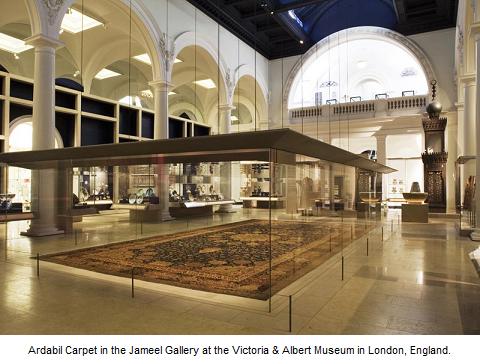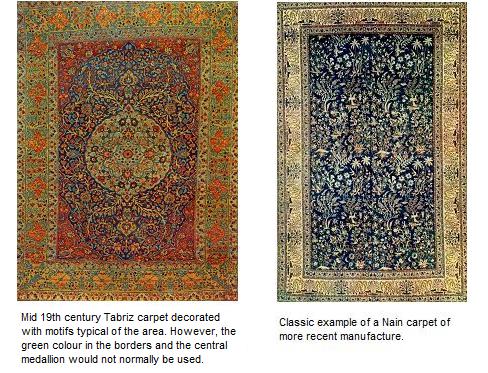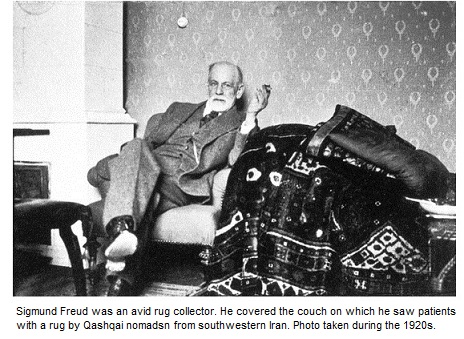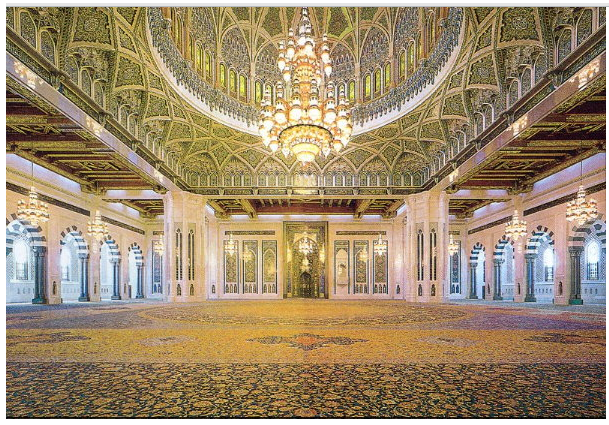The Persian carpet is a part of Persian (Iranian) art and culture. Carpet-weaving in Persia dates back to the Bronze Age. The earliest surviving corpus of Persian carpets come from the Safavid dynasty (1501-1736) in the 16th century. However, painted depictions prove a longer history of production. There is much variety among classical Persian carpets of the 16th and 17th century. Common motifs include scrolling vine networks, arabesques, palmettes, cloud bands, medallions and overlapping geometric compartments rather than animals and humans. This is because Islam, the dominant religion in that part of the world, forbids their depiction. Still, some show figures engaged either in hunt or feasting scenes. The majority of these carpets are wool, but several silk examples produced in Kashan survive. The major centers of antique Persian carpet production in Persia were:
- Tabriz (1500-1550)
- Kashan (1525-1650)
- Herat (1525-1650)
- Kerman/Kirman (1600-1650)

To the left is an early painting from the city of Herat, circa 1420, depicting a woman seated on a rug with the layout of the field bearing a similarity to that which we see in subsequent Turkmen carpet weavings. Additionally, the archaic "Kufic" border pattern seen in old Anatolian rugs is evident. Numerous carpets (between 1500 and 2000) have been conserved since the Safavid period, but the dating and establishment of the origin of these carpets remains very difficult. The inscriptions are a valuable indicator for determining the artists, the places of fabrication, the sponsors, etc. In addition, once a carpet has been made and has stayed in a particular place, it allows other pieces related to it to be identified.

It is generally accepted among specialists that it was the Safavids who transformed the carpet from production by artists assured by nomadic tribes to the status of a "national industry" of which the products were exported to India, into the Ottoman Empire and to Europe. During the Safavid period, the export of carpets flourished, to destinations in Europe (sometimes via the Portuguese colony of Goa) and to the Mughal Empire, where Persian carpets stimulated local production. Some Safavid carpets were also transported by the Dutch East India Company towards Jakarta, Sri Lanka, Malaysia, Kochi, India as well as even to Holland. European orders came to the Persian Empire for the weaving of special carpets: for example, the group of "Polish carpets" was undoubtedly knotted in Isfahan, but certain ones carry the arms of Poland. Below is an example of a "Polish" carpet conserved today at New York's Metropolitan Museum of Fine Arts. It is a floral carpet with an overlying pattern of compartments formed by overlapping cartouches. The pile is silk, highlighted with gold and silver brocading, all in muted colors. These carpets were termed Polonaise by 19th century carpet collectors because their origin in Isfahan was forgotten over the centuries. When, in 1878, a carpet similar to this one was exhibited in Paris, it was widely assumed that the coats of arms woven into the rug were Polish and that the rug was made in Poland.

Based on accounts by travelers and other written sources, it appears that workshops for royal carpets existed in Ispahan, Kashan and Kerman. These workshops produced carpets for the palace and mosques of the Shah, but also to be offered to neighboring monarchs or to foreign dignitaries, or pieces made on order for the nobility or ordinary citizens. Such sponsorship provided capital in the form of raw materials and provided a salary for the artisans for the duration of the weaving. The rapid development of the carpet industry in the Persian Empire during the Safavid period seems to be due to the sovereigns' taste for this art form. Ismail I, then Shah Tahmasp and Shah Abbas I are known for having been personally interested in carpet production. One has also supposed that the two latter sovereigns were personally invested in the production of carpets, notably by the design of the motifs. During their reigns, the production of Persian carpets was the most prominent out of the whole Safavid period. It was in this period and particularly since Shah Tahmasp that the first carpets with floral decoration were created, in order to satisfy the taste of the Safavids. The difference between the carpets of the nomads and the floral ones is due to the role of the "master" (ostad), who draws the pattern which will be reproduced by the knotters. The designs of the carpets of the nomads are themselves transmitted by tradition.

This picture on the right is of Shah Abbas. It is from the ceiling fresco that decorates one of the pavilions in his palace complex in Isfahan. The royal workshops produced carpets for the palace and mosques as well as gifts for neighboring monarchs and foreign dignitaries. Some of those gifts, such as a medallion carpet sent to the Doge of Venice, survive in museums today. The production of carpets was strongly influenced by the leadership of the art of the book, which provided the patterns. Thus, on comparing them with bookbindings and illuminations, specialists have been able to discern a stylistic evolution. Thus, the majority of the carpets produced during the 16th century, that is, principally under Shah Ismail and Shah Tahmasp, are called "with medallion" because they're organized around a large central multi-lobed medallion sometimes called Shamsa, that is "sun", and the corner decorations each carry a quarter of a medallion which is strongly reminiscent of that in the centre. The most famous carpets of this type are the pair of carpets said to be of Ardabil. This pair is known as one of the great treasures of Islamic art and one of the carpets is now the center-piece of the V&A's new Jameel Gallery of Islamic Art. It was commissioned as one of a pair by the ruler of Iran, Shah Tahmasp, for the shrine of his ancestor, Shaykh Safi al-Din, in the town of Ardabil in north-west Iran. It is inscribed at one end with the date 946 in the Muslim calendar, which is equivalent to 1539-40. It is signed "Work of the humble servant of the court of Mahmud Hashani". Its whole surface is covered by a single unified design, an outstanding achievement in any period. Putting a price on this rug would be like putting a price on the Mona Lisa.


From the end of the 16th and the beginning of the 17th century, that is with the coming into power of Shah Abbas, the medallion tended to disappear, since the corner decorations could already have been eliminated by the second half of the 16th century, as is shown by the carpet of Mantes. It's the flowering of "vase carpets", which, as their name indicates, display a vase from which springs a floral arrangement. The garden, which is associated with paradise, equally gives place to a type of composition which appeared in the 17th century in Persia in imitation of the gardens of the Shah, divided in rectangular parcels or squares by alleys and irrigation canals.
There are also carpets with the theme of hunting, an activity prized by the Shahs and requiring address, strength, and knowledge of nature. This theme is also linked to paradise and to spiritual activities, because the hunt often unfolds in a wilderness which can be reminiscent of the gardens of paradise. One of the finest is undoubtedly the apparently tabrizi carpet, currently conserved at the Museo Poldi Pezzoli, and dated 1542-43. The carpet of Mantes from northwestern Iran, shown below and dated to the second half of the 16th century and conserved at the Louvre, is equally of this exemplary caliber. Images of the Mantes carpet depict animal and hunting scenes. The carpet once covered the floor of the collegiate church of Mantes-la-Jolie (Yvelines, France), hence its name.


The village of Kashan for its part was distinguished by a very particular production of relatively small carpets entirely of silk, with a blue or red base, showing fights between fantastic animals borrowed from the Chinese (kilins, dragons, phoenixes). As with the large carpets, those of the 16th century display a medallion (carpet of the Gulbenkian Foundation), which disappeared in the following century. The Louvre and the Metropolitan Museum are each freely conserving an example.
Antique Persian rugs are showcased and conserved in museums around the world as they can also be sold at famous auctions houses. Below are some rare examples of antique Persian rugs surviving until this today and dating back to the last three centuries.
Further below are some examples of the most produced and recognized Persian carpets in the world.





In 2008, Iran's exports of hand-woven carpets was $420 million or 30% of the world's market. It is one of the world's largest producer and exporter of handmade carpets. There is an estimated population of 1.2 million weavers in Iran producing carpets for domestic markets and international export. Iran exports carpets to more than 100 countries, as hand-woven rugs are one of its main non-oil export items. The country produces about five million square meters of carpets annually 80 percent of which are sold in international markets. In recent times Iranian carpets have come under fierce competition from other countries producing reproductions of the original Iranian designs as well as from machine-made carpets. As of 2011, Iran is the maker of the largest handmade carpet in history, measuring 60,546 square feet (5,624.9 square meter) shown below.

The ancient art of Persian carpets is honored at the Carpet Museum in Tehran, Iran. Carpet connoisseurs are welcome to visit anytime of the year. Below you have a preview of some of the rugs and carpets contained in the various collections of the museum in 2016.
Video published on December 10, 2016 on the Ivan Tang channel on YouTube.
Sources and inspiration: Bérinstain, Valérie, et al. L'art du tapis dans le monde (The art of carpets in the world),. Paris: Mengès, 1996. Print.; Jerrehian Jr., Aram K.A. Oriental Rug Primer. Philadelphia: Running Press, 1980. Print.; Herbert, Janice Summers. Oriental Rugs, New York: Macmillan, 1982. Print.; Hackmack, Adolf. Chinese Carpets and Rugs, Rutland and Tokyo: Tuttle, 1980. Print. ; De Moubray, Amicia, and David Black. Carpets for the home, London: Laurence King Publishing, 1999. Print.; Jacobsen, Charles. Oriental Rugs A Complete Guide, Rutland and Tokyo: Tuttle, 1962. Print.; Bashir, S. (n.d.). Personal interview.; Web site sources and dates of consultation vary (to be confirmed). Without prejudice to official usage.


 Tapis d'Orient Bashir | Bashir Persian Rugs
Tapis d'Orient Bashir | Bashir Persian Rugs
 @tapisbashir
@tapisbashir
 @bashircarpets
@bashircarpets
 @bashircarpets
@bashircarpets